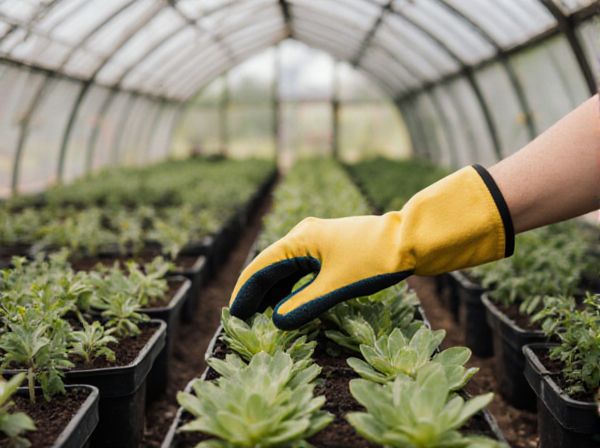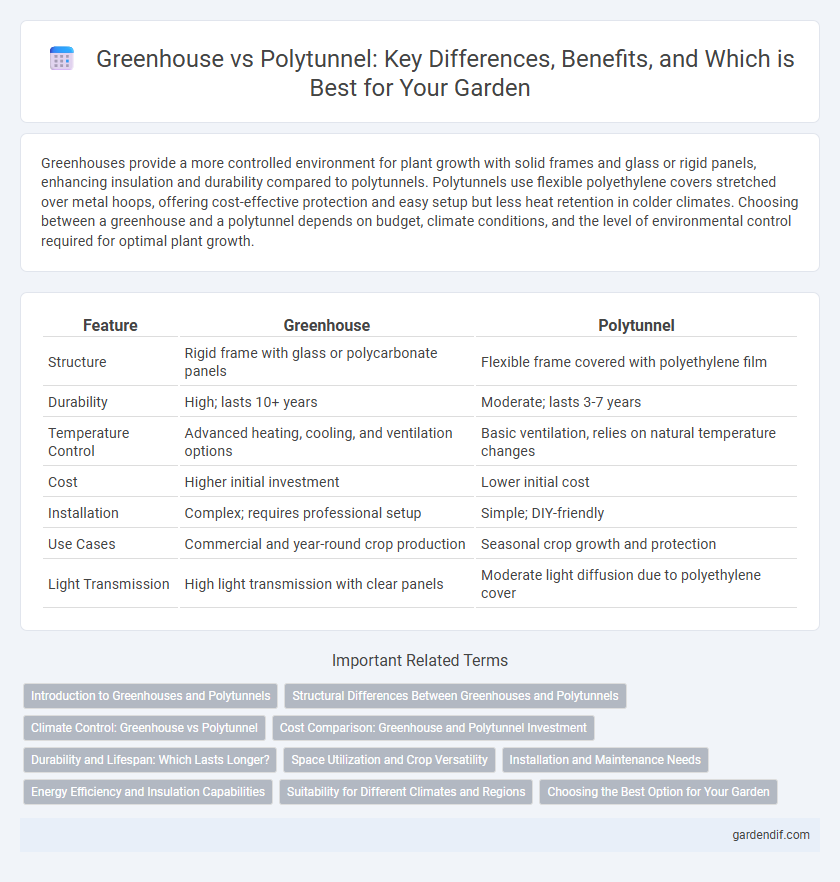
Greenhouse vs Polytunnel Illustration
Greenhouses provide a more controlled environment for plant growth with solid frames and glass or rigid panels, enhancing insulation and durability compared to polytunnels. Polytunnels use flexible polyethylene covers stretched over metal hoops, offering cost-effective protection and easy setup but less heat retention in colder climates. Choosing between a greenhouse and a polytunnel depends on budget, climate conditions, and the level of environmental control required for optimal plant growth.
Table of Comparison
| Feature | Greenhouse | Polytunnel |
|---|---|---|
| Structure | Rigid frame with glass or polycarbonate panels | Flexible frame covered with polyethylene film |
| Durability | High; lasts 10+ years | Moderate; lasts 3-7 years |
| Temperature Control | Advanced heating, cooling, and ventilation options | Basic ventilation, relies on natural temperature changes |
| Cost | Higher initial investment | Lower initial cost |
| Installation | Complex; requires professional setup | Simple; DIY-friendly |
| Use Cases | Commercial and year-round crop production | Seasonal crop growth and protection |
| Light Transmission | High light transmission with clear panels | Moderate light diffusion due to polyethylene cover |
Introduction to Greenhouses and Polytunnels
Greenhouses and polytunnels are essential structures in horticulture designed to extend growing seasons and protect plants from adverse weather conditions. Greenhouses typically feature a rigid frame made of glass or polycarbonate panels, offering superior insulation and durability, while polytunnels use flexible polyethylene covers stretched over metal hoops, providing cost-effective and easy-to-install options. Both systems create controlled environments that optimize temperature and humidity for plant growth, but greenhouses offer more precise climate control and long-term usability compared to polytunnels.
Structural Differences Between Greenhouses and Polytunnels
Greenhouses typically feature a rigid frame made of aluminum, steel, or wood, covered with glass or polycarbonate panels that provide strong structural support and insulation. Polytunnels consist of a flexible metal or plastic hoop frame covered with a polyethylene film, which offers less stability and durability but greater affordability and ease of assembly. The structural differences influence climate control, with greenhouses supporting more advanced ventilation and heating systems compared to the simpler, more temporary polytunnel designs.
Climate Control: Greenhouse vs Polytunnel
Greenhouses offer superior climate control with automated heating, cooling, and ventilation systems that maintain optimal temperature and humidity levels year-round. Polytunnels rely more on manual adjustments like rolling up sides or opening doors, making precise climate regulation more challenging. This advanced environmental management in greenhouses supports consistent plant growth and higher yields.
Cost Comparison: Greenhouse and Polytunnel Investment
Greenhouses typically require a higher initial investment due to their sturdy frame materials, glazing options like glass or polycarbonate, and integrated climate control systems, often costing between $3,000 to $10,000 depending on size. Polytunnels offer a more budget-friendly option, with setup costs ranging from $500 to $3,000, prioritizing affordability through polyethylene covers and simpler construction. Long-term maintenance and operational expenses also tend to be higher for greenhouses due to heating, cooling, and ventilation needs, whereas polytunnels have lower ongoing costs but may have reduced durability over time.
Durability and Lifespan: Which Lasts Longer?
Greenhouses typically offer greater durability and a longer lifespan due to their robust aluminum or galvanized steel frames and impact-resistant glass or polycarbonate panels, often lasting 15 to 20 years or more with proper maintenance. Polytunnels, constructed with lightweight galvanized steel hoops and polyethylene covers, generally have a shorter lifespan of around 5 to 10 years as the plastic sheeting is prone to tearing and UV degradation. For gardeners seeking long-term investment and structural resilience, greenhouses provide superior longevity compared to polytunnels.
Space Utilization and Crop Versatility
Greenhouses provide superior space utilization with vertical growing systems and tiered shelving, maximizing the available area for diverse crops. Polytunnels offer flexible crop versatility by accommodating a wide range of plant types and sizes due to their spacious, unobstructed interior. Efficient climate control in greenhouses supports year-round cultivation of high-value crops, while polytunnels excel in seasonal, larger-scale planting.
Installation and Maintenance Needs
Greenhouses typically require a more complex installation process involving foundation work, electrical setup, and ventilation systems, making initial costs higher compared to polytunnels. Polytunnels offer simpler, quicker assembly with lightweight frames and plastic covers, reducing installation time and skill requirements. Maintenance for greenhouses often involves regular cleaning, climate control adjustments, and structural inspections, while polytunnels mainly need periodic cover replacement and frame stability checks.
Energy Efficiency and Insulation Capabilities
Greenhouses offer superior energy efficiency compared to polytunnels due to their rigid, insulated panels that retain heat effectively, reducing the need for additional heating. Polytunnels rely on flexible plastic covers that provide less insulation, leading to higher heat loss and increased energy consumption. Enhanced insulation capabilities in greenhouses support consistent temperature control, making them ideal for energy-conscious growers seeking sustainable cultivation solutions.
Suitability for Different Climates and Regions
Greenhouses provide controlled environments ideal for diverse climates, enabling year-round cultivation by regulating temperature, humidity, and light, making them suitable for colder or variable regions. Polytunnels, constructed with flexible plastic covers, offer moderate protection primarily suited for temperate climates, enhancing early planting and extending growing seasons but less effective against extreme cold. Choosing between a greenhouse and a polytunnel depends on local climate severity, crop sensitivity, and the level of environmental control required for optimal plant growth.
Choosing the Best Option for Your Garden
Greenhouses provide a controlled environment with advanced temperature and humidity regulation, ideal for year-round gardening and delicate plants. Polytunnels offer a cost-effective, flexible structure that extends the growing season while protecting crops from harsh weather. Selecting the best option depends on garden size, budget, and the specific plants you intend to cultivate.
Greenhouse vs Polytunnel Infographic

 gardendif.com
gardendif.com